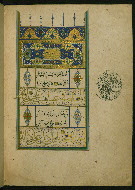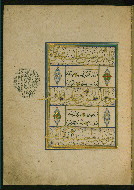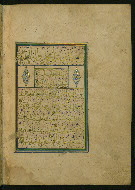Home > Digitized Walters Manuscripts
This document is a tranformation of a TEI P5 XML manuscript description incorporating images. If you have trouble reading special or non-Latin characters on this page, please make sure you have appropriate Unicode fonts installed and an up-to-date web browser.
Walters Ms. W.579, Prayer
Browse images (Browse images in a new window) | TEI in XML format
W.579
Prayer
Vernacular: مفتاح النجاح المكنى بالوسيلة الى كل حزب وفلاح
Authority name: ʿAlī ibn Abī Ṭālib, Caliph, ca. 600-661
As-written name: ʿAlī ibn Abī Ṭālib
Name, in vernacular: علي بن ابي طالب
Note: Author dates preferred by cataloger: d. 40 AH / 661 CE
This illuminated manuscript is of a prayer (wird) called Miftāḥ al-najāḥ, attributed to ʿAlī ibn Abī Ṭālib, the fourth caliph of Islam. According to the colophon, it was completed by Shaykh Kamāl ibn ʿAbd al-Ḥaqq al-Sabzawārī, the calligrapher and illuminator, in Astarabad (present-day Gorgan, Iran) in 941 AH / 1534 CE. The text, divided into five compartments, is in calligraphic vocalized naskh in black ink and vocalized thuluth in gold ink outlined in black. Illuminated rosettes with colored dots serve as verse markers. The decorated colophon (fol. 8b) is written in tawqīʿ/riqāʿ script in gold ink. Later bequest (waqf) seal impressions of the Vizier al-Shahīd ʿAlī Pāshā, dated 1130 AH / 1717 CE, appear on fols. 2a, 2b, and 3a. The brown leather binding with interconnected gold-tooled lobed medallions and discs and doublures with filigree decoration is original to the manuscript.
941 AH / 1534 CE
Astarābād (Iran)
As-written name: Kamāl ibn ʿAbd al-Ḥaqq al-Sabzawārī
Name, in vernacular: كمال بن عبد الحق السبزواري
Note: Calligrapher also illuminator (see colophon)
Book
Devotional
The primary language in this manuscript is Arabic.
- Transliteration: tammat al-daʿwāt al-mubārakāt /1/ bi-ḥamdi Allāhi taʿālá wa-mannihi al-karīm /2/ ʿalá al-yadi al-ʿabd al-mudhnib al-rājī ilá raḥmati Allāh al-maliki /3/ al-raḥīm al-bārī shaykh Kamāl ibn ʿAbd al-Ḥaqq al-Sabzawārī /4/ tajāwaza Allāhu ʿan sayyiʾatihimā bi-baldah ṭayyibah Ustarābād [sic] ḥummiyat /5/ ʿan al-afāti wa-al-balīyāti fī shuhūr sanat iḥdá wa-/6/ arbaʿīn wa-tisʿimiʾatin min al-hijrah muḥarriruhā wa-mudhahhibuhā wa-kātibuhā /7/
- Comment: Colophon gives the full name of the calligrapher/illuminator, Kamāl ibn ʿAbd al-Ḥaqq al-Sabzawārī, with the date 941 AH / 1534 CE and place name Astarābād
Paper
Laid paper
Foliation: i+9+i
Catchwords: None
16.5 cm wide by 23.5 cm high
8.5 cm wide by 13.0 cm high
- Columns: 1
- Ruled lines: 7
- Text divided into five compartments: three compartments across the written surface and two compartments indented with panels 2 cm in width on each side; framing lines in dark blue, black, gold, light green, and red
- Title: Miftāḥ al-najāḥ al-mukanná bi-al-wasīlah ilá kull ḥizb wa-falāḥ
- Author: ʿAlī ibn Abī Ṭālib, Caliph, ca. 600-661
- Scribe: Kamāl ibn ʿAbd al-Ḥaqq al-Sabzawārī
- Incipit: اللهم يا من دلع لسان الصباح بنطق تبلجه ...
- Hand note: Written in calligraphic vocalized naskh script in black ink; vocalized thuluth script in gold ink outlined in black (top, middle, and bottom lines); colophon in tawqīʿ/riqāʿ script in gold ink, both vocalized
- Decoration note: Illuminated headpiece with the basmalah in tawqīʿ script (fol. 2b); illuminated colophon (fol. 8b); text in black and gold with blue decoration, divided into compartments; polychrome text frame; contours of the thuluth-script lines decorated with blue tendrils over a ground of red hatched lines; naskh-script panels flanked by polychrome medallions with gold-tooled outlines; illuminated rosette verse markers with colored dots
fol. 2b:

- Title: Incipit with illuminated headpiece
- Form: Incipit; headpiece
- Label: This manuscript opens with an illuminated headpiece containing a cartouche with the doxological formula (basmalah) in tawqīʿ script. Fluid and curvilinear, tawqīʿ script is used for headings and rarely used for the main text. As seen here, while having inscribed the headpiece in tawqīʿ script, the scribe wrote the main text in alternating black naskh and gold thuluth script. The naskh-script panels are framed by medallions with a gold outline. The contours of the thuluth-script lines are decorated with blue tendrils over a ground of red hatched lines. Gold rosettes mark the verse endings. The stamp in the right margin is the personal seal of the Vizier ʿAlī Pāshā, who gave the manuscript to an educational charity in 1130 AH / 1717 CE.
fol. 3a:

- Title: Illuminated text page with seal
- Form: Text page; seal
- Label: This text page is defined by the use of alternating black naskh and gold thuluth scripts. The naskh-script panels are flanked by illuminated medallions with a gold outline. The gold thuluth-script lines are set apart by outlines resembling clouds. Illuminated rosettes serve as verse markers. The stamp in the left margin is the personal seal of the Vizier ʿAlī Pāshā, who gave the manuscript to an educational charity in 1130 AH / 1717 CE.
fol. 8b:
The binding is original.
Brown leather (with flap); interconnected gold-tooled lobed medallions and discs with vine and floral motifs; inner frame with vine and scroll motif; gold-tooled outer frame; doublures with central lobed oval and corner pendants with filigree decoration on a blue ground
Waqf seal impression of the Vizier al-Shahīd ʿAlī Pāshā, dated 1130 AH / 1717 CE, with the original shelf mark 1414 (fols. 2a, 2b, and 3a)
Walters Art Museum, 1931, by Henry Walters bequest
Brockelmann, Carl. Geschichte der arabischen Litteratur (New York; Köln: E.J. Brill, 1996), 1:44.
Principal cataloger: Gacek, Adam
Catalogers: Landau, Amy; Smith, Sita
Editor: Bockrath, Diane
Conservators: Jewell, Stephanie; Quandt, Abigail
Contributors: Barrera, Christina; Emery, Doug; Herbert, Lynley; Noel, William; Simpson, Shreve; Tabritha, Ariel; Toth, Michael B.; Valle, Chiara
The Walters Art Museum
Licensed for use under Creative Commons Attribution-NonCommercial-ShareAlike 3.0 Unported Access Rights, http://creativecommons.org/licenses/by-nc-sa/3.0/legalcode. It is requested that copies of any published articles based on the information in this data set be sent to the curator of manuscripts, The Walters Art Museum, 600 North Charles Street, Baltimore MD 21201.
